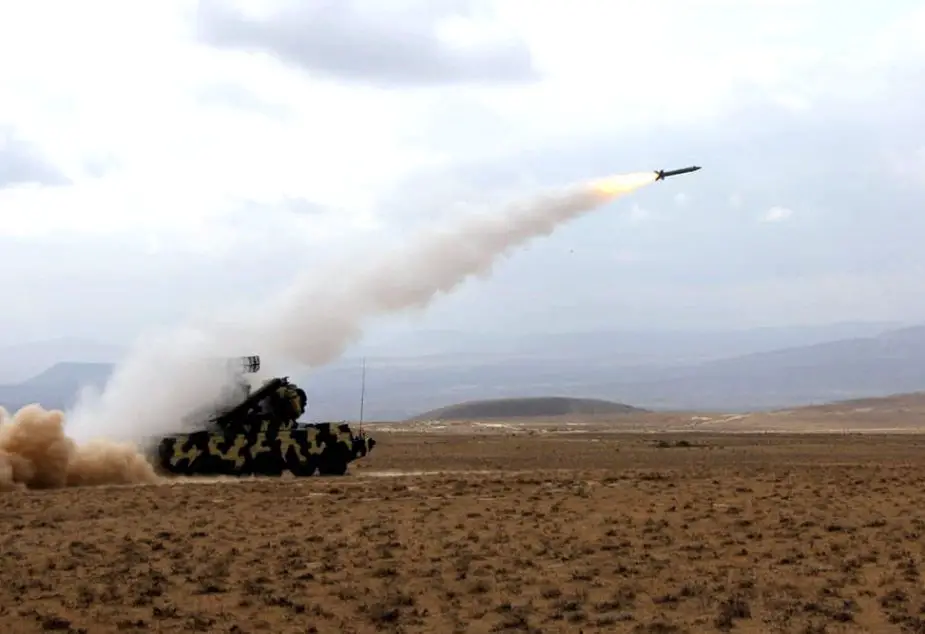According to the combat training plan for 2018, the air defense units of Azerbaijan's army conducted tactical exercises in various firing ranges, the Ministry of Defense of the Republic of Azerbaijan said in a message on October 17. In the course of the exercises the air defense units fire-tested the 9K33 Osa anti-aircraft missile system.

Firing of a 9K33 Osa air defense missile by the Azeri army (Picture source: Azeri MoD)
The 9K33 Osa (NATO Code: SA-8 Gecko) is a highly mobile, low-altitude, short-range tactical surface-to-air missile system designed in the Soviet Union. Its export version name is Romb. The SA-8 was the first mobile air defense missile system incorporating its own engagement radars on a single vehicle.
All versions of the 9K33 feature all-in-one 9A33 transporter erector launcher and radar (TELAR) vehicles which can detect, track and engage aircraft independently or with the aid of regimental surveillance radars. The six-wheeled transport vehicles BAZ-5937 are fully amphibious and air transportable. The road range is about 500 km.
The 1S51M3-2 radar system on the SA-8 TELAR received the NATO codename Land Roll. It was derived from the naval `Pop Group' radar system but is smaller since it does not require the elaborate stabilisation system. An improved system designated the SA-8B `Gecko' Mod 1, was first seen in Germany in 1980. It had improvements added to the launcher configuration, carrying six missiles in ribbed containers. The system is reported to be of the frequency-agile monopulse type. It consists of an elliptical rotating surveillance antenna mounted on top of the array, operates in H band (6 to 8 GHz) and has a 30 km acquisition range against most targets. The large pulsed J band (14.5 GHz) engagement antenna is mounted below it in the centre of the array and has a maximum tracking range of about 20 km.
Mounted on either side of the tracking radar antenna is a small J band parabolic dish antenna to track the missile. Below that is a small circular antenna which emits an I band uplink capture beam to gather the missile shortly after launch. The final antennas in the array are two small white rectangular ones, one on either side of the array mounted alongside the I band. These are used for command uplink to the missile. This twin antenna system permits the 'Land Roll' radar to control up to two missiles simultaneously against a single target. Furthermore, the two missiles can be guided on different frequencies to further complicate ECM. There is also a tubular device fitted to and above the tracking radar; this is a 9Sh33 electro-optical tracker. It can be used to track the target when the main tracking radar is jammed by ECM.
A 9K33 battery comprises four 9A33B TELAR vehicles and two 9T217 transloader vehicles on BAZ-5939 chassis with reload missiles and a crane. A reload time of five minutes has been reported per TELAR.
In addition to the TELARs, each regiment is also assigned a single radar collimation vehicle 9V914 (initially on the BAZ-5938 chassis but more often found on the ZiL-131 truck). This vehicle assists in the alignment of the TELAR's radar systems, ensuring accurate target tracking and engagement.
Engagement range for the early versions is approximately 2–9 km (1.3–5.6 miles) and engagement altitudes of between 50–5,000 m (164–16,400 ft). The 9M33M2 "Osa-A" missile extends the ranges out to 1,500–10,000m (1–6.2 miles) and engagement altitudes to 25–5,000 m (82–16,400 ft). The 9M33M3 missile greatly enhances the altitude engagement envelope to 10–12,000 m (33–42,500 ft), and as such are also able to fly further (about 15 km/9 miles) but the system is not able to engage targets at longer ranges, due to other factors such as the radar tracking of the missiles. The system is designed for use primarily against jet aircraft and helicopters in any kind of weather.
The 9M33 missiles are 3.158 m (10.3 ft) long, weigh 126 kg (278 lb) and use command guidance. There is also a backup low-light optical tracking system for heavy ECM environments. The latest 9M33M3 missiles have an increased total weight of 170 kg (375 lb) in order to provide the extended range coverage and larger warhead. Propulsion is provided by a dual-thrust solid fuel rocket motor. Both versions feature a missile speed of around Mach 2.4 (peaking at around Mach 3) for a maximum target engagement speed of around Mach 1.4 for the original missile and Mach 1.6 for the M2\M3 missiles. The warhead for the initial and M2 versions weighs 19 kg (42 pounds), increased to 40 kg (88 lb) in the M3 version to improve performance against helicopters. All versions have impact and proximity fuzes.
There have been unconfirmed reports of other possible versions of the missile with both infra-red and semi-active radar terminal homing seekers.














